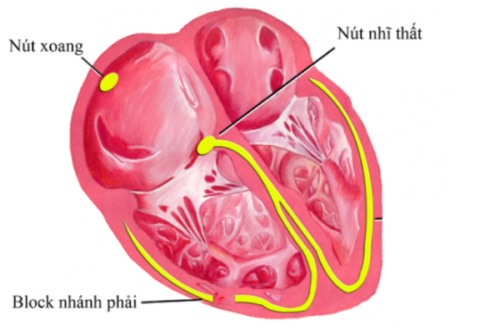Right bundle branch block: Causes, symptoms and treatment

Right bundle branch block is not a serious condition, but it can lead to shortness of breath, palpitations, or chest pain. So what should you do to stabilize your heart rate and prevent the disease from progressing?
Symptoms of a slow heart rate, dizziness, and fatigue can sometimes be caused by right bundle branch block, which slows the heart and makes it unable to supply enough blood to the organs. Join SignsSymptomsList.com to find out if right bundle branch block is dangerous and how to keep your heart rate stable to ensure health.
What is right bundle branch block?

Electrical impulses that are interrupted when passing through the right branch of the heart is called right bundle branch block.
Right bundle branch block is a condition in which the electrical impulses passing through the right side of the heart are interrupted while the left side remains normal, causing the left and right sides of the heart to contract at the same time.
Branch blocks must be divided into two types, complete and incomplete blocks. In which, incomplete right bundle branch block is a lightweight version of complete right bundle branch block.
Causes of right bundle branch block

The heart's electrical conduction system in the right ventricle (lower right chamber of the heart) is not wrapped in muscle as firmly as the left ventricle, so it is easy to rupture, dilate and cause right bundle branch heart block. In addition, cardiovascular diseases that damage the ventricular muscle or cause chronic elevation of right ventricular pressure can also cause right bundle branch block. Diseases may include:
- Diseases causing damage to the heart: coronary artery disease, myocarditis, congenital heart disease (ventricular septal defect, atrial septal defect), valvular heart disease, myocardial infarction.
- Diseases and risk factors for increased pulmonary arterial pressure: Chronic obstructive pulmonary disease (COPD), pulmonary embolism due to thrombosis or respiratory disorders (sleep apnea), right heart failure.
In addition, sinus node failure due to old age or excessive hyperkalemia can also cause this condition.
Symptoms of right bundle branch block

The sign of right bundle branch block is rarely present in patients with isolated bundle branch block but is often present in those with other underlying cardiovascular diseases. This block can then cause symptoms such as:
- Empty chest
- Dizziness, lightheadedness
- Chest pain, chest heaviness
- Shortness of breath, easy fatigue when exercising
If there is complete right bundle branch block, a heart rate drop to 40 beats/min will significantly reduce the pumping function of the heart in people with comorbid heart, lung, or sinus node insufficiency. The slow heart beat leads to lack of blood to the organs, especially the brain, causing symptoms of fatigue, fainting, and temporary cardiac arrest.
You can easily detect bundle branch block by electrocardiogram thanks to the characteristic change in ECG waveform. However, to make an accurate diagnosis, doctors will still have to base on medical history, symptoms, echocardiography, blood tests or chest X-ray to screen for the cause of heart block.
Treatment of right bundle branch block
Depending on your health situation, this condition is treated with different methods.
In healthy people
If you do not have heart or lung disease, right bundle branch block is not considered a disease because it rarely affects the pumping function of the heart and does not require treatment. However, patients need to be examined periodically every 1-2 years and have an electrocardiogram (ECG) to monitor disease progression if right bundle branch block is detected.
In people with cardiovascular disease or chronic obstructive pulmonary disease
When the right bundle branch block is mild (not completely blocked), the disease can easily progress to the severe form (complete right bundle branch block). At that time, the treatment process should focus on controlling the cause of the disease.
Some cases of severe right bundle branch block (such as sinus node syndrome, after myocardial infarction ...) cause bradycardia with high risk of death, requiring permanent pacemaker placement.
What should you do when you have right bundle branch block?

In addition to using medications as directed by your doctor, if available, you need regular health checkups and lifestyle changes to reduce the risk of potential heart and lung diseases. Here are a few things you can do for reference:
- Monitor disease symptoms regularly and re-examine as soon as there are signs of chest pain, shortness of breath, fainting or other abnormalities affecting health.
- Quit smoking and lose weight if you are overweight.
- Eat heart-healthy foods like green vegetables, fruits because these foods contain a lot of fiber that helps lower cholesterol, lower blood fats and reduce the risk of heart disease.
- Exercise to increase the contractility of the heart by walking instead of taking the elevator, practicing yoga, cycling, practicing Tai Chi...